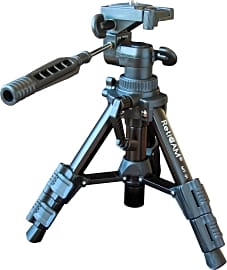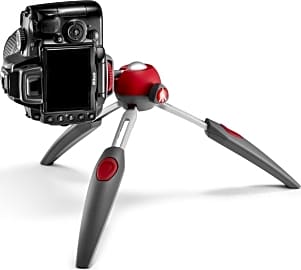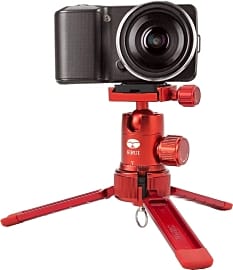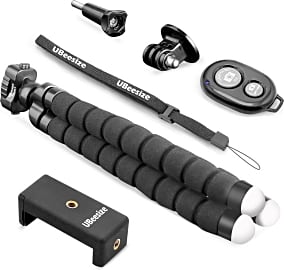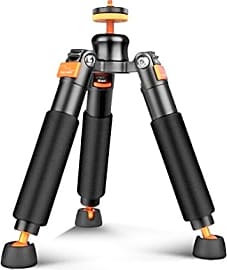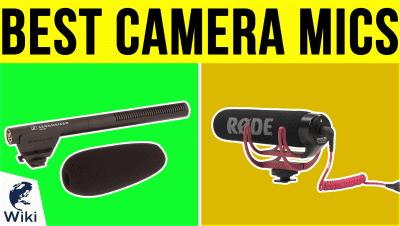The 10 Best Mini Tripods

This wiki has been updated 45 times since it was first published in September of 2015. Standard tripods are best in professional, controlled settings, but what if you’re on the move in a fast-paced environment? These mini models are a nice solution, as they’re highly portable, yet sturdy enough to let you capture a quality, stable shot. Frequent travelers and amateur outdoor photographers and videographers are especially big fans of these versatile items. When users buy our independently chosen editorial recommendations, we may earn commissions to help fund the Wiki.
Editor's Notes
November 29, 2020:
While we still stand by many of our previous recommendations, we did make a few changes to increase the versatility of the offerings. For example, we removed the ZaxSound Pistol because we didn't feel it was notably different than the Altura Stand QZ0312, and we believe the latter has a better build quality. In its place came the Sirui 3T-35, which is significantly more rugged, thanks to its aluminum build, and boasts more than three times the load capacity. We also think many users will appreciate the telescoping center column, however, that being said, it is a bit unstable at full extension if you are using it with large, awkwardly balanced DLSRs that have long telephoto lenses attached to them.
Another model we removed during this update was the Avawo Wrapable. Though we like its flexible design that can be affixed to a variety of objects, the Fotopro UFO2 and UBeesize S Premium both offer that same ability, and they have the added benefit of coming with remote shutter controllers and phone clamps. In its place came the Joby Gorillapod Rig, which also features flexible legs for wrapping around poles and branches but includes three mounts, so you can attach a DSLR, a microphone, and a light, all at the same time. Alternatively you could attach DSLR and an action camera, allowing you to capture stills and shoot video simultaneously.
One final substitution we made was to swap the Manfrotto Pixi out for the Manfrotto Pixi Evo 2. Though the designs are similar, the latter has extendable legs and supports a greater payload, making it an overall more versatile model.
April 25, 2019:
Upon review, we found that the Pedco UltraPod II is an outdated model, and it appears the newest version of this item leaves much to be desired: users reported that it requires an inordinate amount of adjusting to stabilize, and its plastic components tend to wear down over time, which can render the holder useless.
Added the Fotopro UFO2 to provide one more model with flexible, grippy legs. Unlike traditional tripods, these can be configured for mounting to all kinds of surfaces — like poles, railings, tree branches, and bikes — in addition to normal places like tabletops. Reports highlight the Bluetooth remote that comes with it, which allows you to snap photos or record videos from a distance.
In evaluating reports of the Neewer Portable, a couple sentiments stuck out: users appreciate its ability to hold heavy cameras (up to 11 pounds) steady, whereas a common complaint with other models is an inability to do just that. Another feature is the ability to adjust legs individually, which provides enhanced flexibility in terms of where it can be set up.
Stabilize Your Life
If you look back at any home video footage from those days, I'm sure it's a little shaky.
I often think about the photo albums collecting dust in my mother's basement. Since the dawn of consumer photography, we've had to save our photographs in thick, sticky albums or cram them into old shoe boxes–I even had a kitchen drawer in my house growing up that was filled with photographs.
We do the best that we can to collect memories, even if it means going to these silly lengths. My kids aren't going to have quite the same experience though. They're going to think of a specific, electronically partitioned collection of digital images whenever they hear the words 'photo album.'
However the medium changes, one thing remains a challenge: stability. When you pour back over the hundreds or thousands of photos you took or had taken of you growing up, some of them are probably a little blurry. If you look back at any home video footage from those days, I'm sure it's a little shaky. Well, go check your Instagram feed. Go watch some YouTube videos shot on the fly with a cell phone. The technology has come a long way, but the same old problems of blurriness and shakiness remain.
To capture your memories with the greatest possible clarity and steadiness, you'd do well to invest in one of these miniature tripods, each one of which sports a male 1/4" 20 thread mount. That means that no matter the camera–so long as you don't exceed the tripod's weight limitation–you can undoubtedly hook it up.
The reason these tripods provide so much stability is that they utilize the very simple mathematical fact that the triangle is the sturdiest of all shapes. Made three-dimensional in the build of a tripod, you gain more stability from three legs than you would from any other organization.
Standing On Your Own Three Feet
You might be surprised by how many favorable surfaces you discover on which you might set up a mini tripod. One of my most fervent suspicions about them before trying them out for myself was that their working height would present endless challenges, but everything from a table-top, to a stack of books, to a mantle by the fireplace will come to your immediate and reliable rescue should you need any extra shooting height.
Whatever you want to mount on your tripod, make sure you have all the potential weight data in place before you take the plunge, less your camera take the plunge for you.
With that in mind, the act of choosing one tripod from among the ten on our list comes down more to weight restrictions, head style, and portability.nAs far as weight consideration goes, any of the tripods on our list should support every cell phone and point-and-shoot digital camera on the market.
Some smaller DSLRs and mirrorless cameras with interchangeable lenses might even come light enough to operate on a mini tripod without too much worry. Whatever you want to mount on your tripod, make sure you have all the potential weight data in place before you take the plunge, less your camera take the plunge for you.
Seven out of the ten tripods on our list come equipped with ball heads, which allow you to loosen and adjust the positioning of your camera with ease and alacrity, though leveling a camera without an internal virtual horizon can be a challenge, and ball heads aren't great for video if you want to pan or tilt.
For a little more articulation, especially in video, you want to investigate a mini tripod with a video head, which you can distinguish from the ball type by the long, straight handle jutting out from its underside.
Finally comes the question of portability, which is one of the most important aspects in a tripod of such Lilliputian stature. Measure out the open space in your camera bag or luggage that you plan on dedicating to your new tripod. If one of the tripods on this list won't fit, keep moving down the list until you find one that will.
Small And Sturdy Wins The Race
In the earliest days of photography, the methods of exposure necessitated incredibly slow shutter speeds. These days, if you find yourself opening your shutter for anything more that 1/20 of a second, you're liable to get significant blurring in your subject. Yet, the photographers of yore often had their subjects sitting for upwards of several minutes just to snag a simple portrait.
These days, if you find yourself opening your shutter for anything more that 1/20 of a second, you're liable to get significant blurring in your subject.
So it was that photographers very quickly reached for a standard piece of equipment used in land surveying: an elongated wooden tripod. By this time, the surveyors had figured out how to create tripods that could collapse on themselves, so photographers could, if they could afford to, invest in a tripod that was portable enough for them to take along with their outfit on horseback.
Those early cameras, in addition to having such long exposure times, were also pretty darn big. Since those days, providing quality photography in smaller systems has been one of the primary drivers of the industry. After the digital revolution of the 1990s led photography into an unprecedented consumer age, a slew of companies developed tripods geared toward the most casual shooters.
These consumers had much smaller cameras in their arsenal, and limitations in low-light performance often resulted in blurry or grainy pictures. To battle against this, several companies put out tripods specifically for smaller, lighter, consumer digital cameras, empowering shooters the world over with a stabilizing force for their photography.



